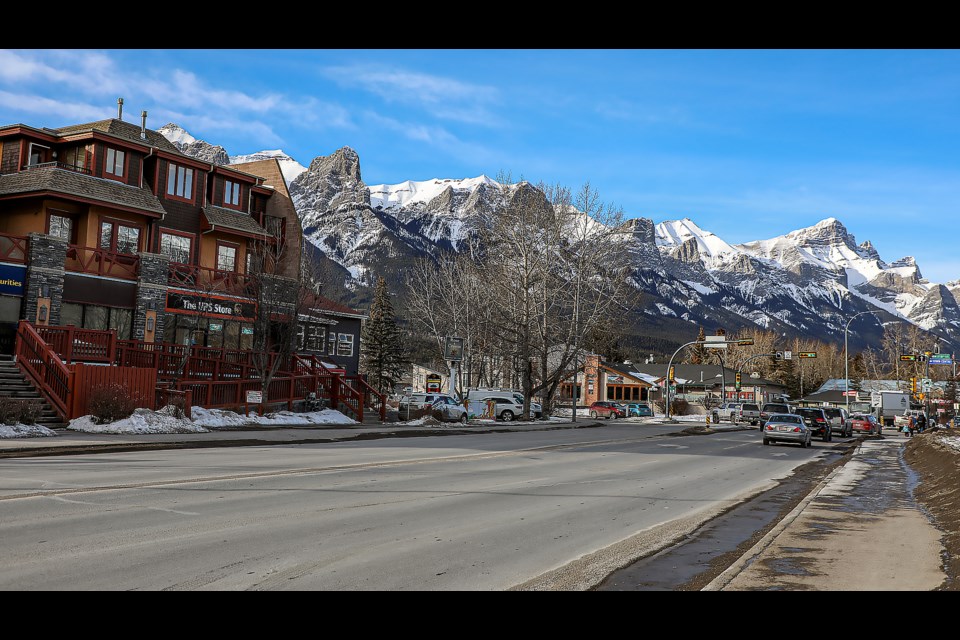CANMORE – Drivers, pedestrians and cyclists will have a better idea of what the central section of Railway Avenue will look like in the coming years.
Canmore council approved the design for the Railway Avenue central project and waterline work was added, with $150,000 set to come from the water utility reserve.
“Once complete, this project will bring our community another large step forward in sustainably managing our transportation network in a way that’s safe and inclusive while allowing for positive impacts of growth while minimizing the negative impacts,” said Andy Esarte, the Town’s manager of engineering.
While the project has been polarizing in segments of the community, the intent of the project has been aligned with Town policies on not solely relying on vehicle transit but active modes such as cycling and walking.
“I’m very excited for this project. … Every time we expand and make those connections, our overall transportation system gets stronger,” said Mayor Sean Krausert.
But with Railway Avenue being a central roadway for visitors and residents, the construction is likely to impact the community in the short-term. Esarte said the intent is to have one lane remain open for each direction throughout the bulk of construction.
“Short of firebombing our entire downtown grid, we need to find ways to make space for each other,” said Coun. Joanna McCallum. “The more comfortable the facilities are, studies have shown the more people will get on their bike … I’m happy to see these changes.”
Town staff last presented an updated summary in May to committee of the whole, which included an updated conceptual design following public engagement.
Among the changes were a central median being removed to allow for left turn access, additional turn bays added and lengthened for the Main Street and 10 Street intersections, bus pullouts being added for transit stops and sections of the cycling path and sidewalk being widened and the crossing at Elevation Place being changed for enhanced safety.
The two intersections would use near-side signals.
The staff report noted lessons from the first phase of Railway Avenue work were applied to the improvements.
The report also highlights with the Utility Master Plan being presented to council – but not approved by council as in previous versions – recommends waterlines be replaced in 15 years and staff recommended it instead take place at the same time as construction for $150,000 from the utility water reserve.
The project staging would see design work ongoing until November, with the construction tender going out later this year or early 2024, deep utility work starting in spring 2024 and surface work not starting until June 2025.
Coun. Tanya Foubert supported the project, but voted against the waterline replacement due to the Utility Master Plan not yet being approved by council.
“I find myself in a bit of a pickle because I’m not opposed to this project, but I have concerns around the process on how this motion is in front of us,” she said. “I think the Utility Master Plan should be approved by council before it’s used to make budget decisions.”
Foubert also noted when Town council and staff met with Jan and Adam Waterous, the placement of the train station for the proposed Calgary to Banff rail line was near the Railway Avenue stop.
She asked if it was better to gain more clarity on the future of the proposed rail line before moving forward with construction, but Esarte said there wouldn’t be any change of it being a feasible location since there’d still be access.
The design was updated during public engagement, via online and an open house earlier in the year, resulting in changes to the original concept. The online portion had 378 submissions provided.
The street is expected to handle more than 18,000 vehicles a day. The average is 14,000 a day now and a peak of 17,000.
If the Town’s mode shift goals of having at least 40 per cent of non-vehicle traffic at peak times is achieved, it’s expected Railway Avenue would have about 13,900 vehicles a day.
Town staff previously told council a daily average of 4,000 pedestrians and cyclists travel through the intersection at Bow Valley Trail and Railway Avenue in the summer.
The Railway Avenue project has three phases, with the first being done in 2020 and 2021 which led to the new intersection at Railway Avenue and Benchland and Bow Valley trails.
The project is part of the Town’s 2018 Integrated Transportation Plan, which prioritizes active modes of transit rather than solely vehicle traffic.
The third phase would focus on the north section of Railway Avenue and be completed up to 17th Street.
The 10th Street intersection, however, was recommended to be pushed back to a future phase due to the consultant recommending only completing the Main Street intersection first, the waterline scope adding construction time and the cost of work exceeding existing budget placeholders.
Though a controversial and divisive topic in the community, the intersection at Bow Valley and Benchlands trails and Railway Avenue has aided in moving traffic, according to statistics.
Esarte said under the old style, a maximum of 650 vehicles would move through the intersection every 15 minutes. During Canada Day weekend, the new intersection design had 745 vehicles per 15 minutes. However, it also led to hundreds of pedestrians and cyclists being moved at the same time.
“From a moving people perspective, we’ve reached the point where it’s actually moving huge numbers of cars at the same time as moving a huge number of people walking and cycling and that’s really difficult in a traditional North American context,” he said. “From a traffic management perspective, it’s working quite well.”




